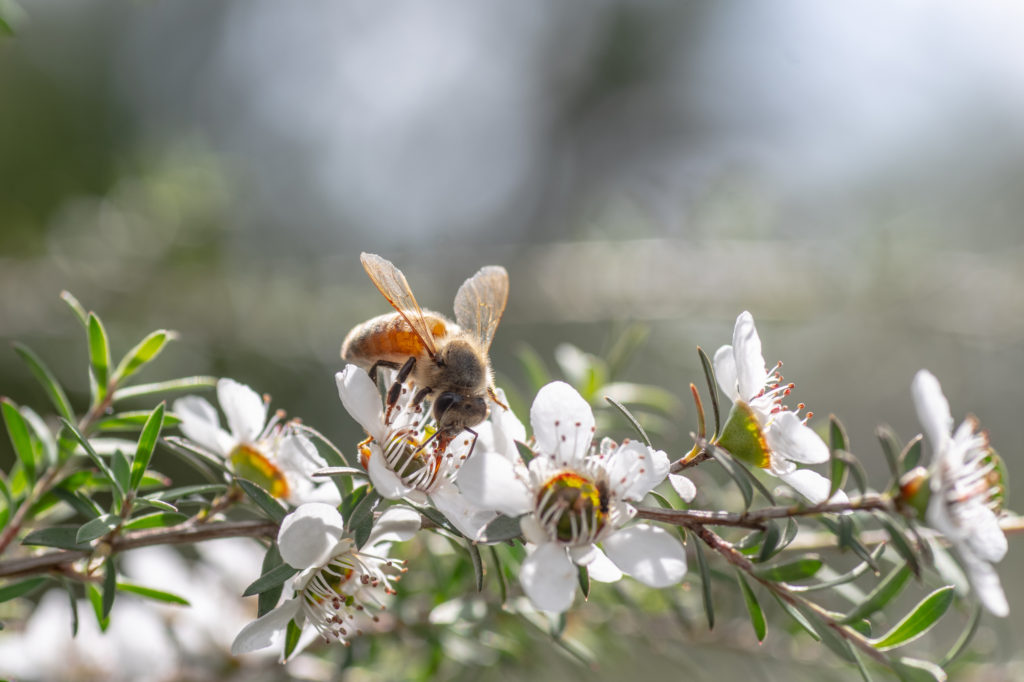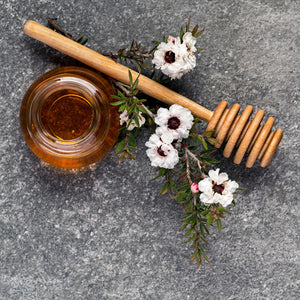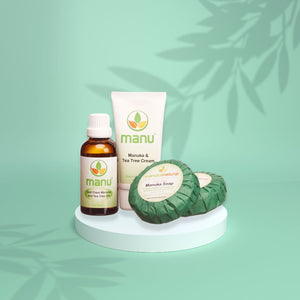
Manuka honey , MGO vs UMF, what it means
What does the term MGO mean in Manuka honey?
You might be wondering, what is MGO in manuka honey?
Methylglyoxal is the key ingredient in Manuka honey that produces its antibacterial properties. Scientists are still researching how this compound works with other components, but they do know its potency is beyond what you can expect in honey.
To elaborate… you should first know that Manuka honey has a superhero-like birth and the story goes like this:
Peter Molan looked at the results in disbelief and then showed them to his lab partners Nicolette Brady and Kerry Allen.
“I think that something is wrong with this equipment. I heated this Leptospermum scoparium honey in what I believe is 95’C, and yet its bacteria-killing properties are still going strong.
The funny thing is that I’m doing it for an hour.
So, either this instrument is broken, or this honey has some out of this Earth qualities. “
That activity became known as Non-Peroxide Antibacterial Activity (NPA).
Dr. Molan researched this activity over many years and found that it was very stable in Manuka honey. It could withstand both heat and light exposure and remain highly active and influential.
Leptospermum scoparium and Manuka honey
The Latin name for the tree that produces this unique nectar is Leptospermum scoparium. It is also known as the “tea tree.”
The Manuka tree is a shrubby evergreen plant that grows up to 5 meters in height in the wilds of New Zealand. It has been known to the indigenous population for centuries.
Otherwise, this island is specific for its vibrant flora and fauna and is unique in the world.
Bees make honey from Manuka’s nectar, which is darker and tastier than all the others. The flowers of the plant are attractive white-pink colors and have a more intense scent.
In 1981, however, the researchers at New Zealand University discovered that Manuka has considerably higher enzymes than regular honey, making it even more beneficial to those who consume it regularly or use it as a topical treatment on wounds and cuts.
The antibacterial activity of manuka honey was significantly higher than that of clover and heather honey that were most common in New Zealand.
This is because Manuka honey has expressed non-peroxide activity that came from the nectar of flowers of the Manuka tree and is responsible for its high antibacterial activity.
However, the non-peroxide activity was only found in honey samples from Manuka and a few from viper’s bugloss (but the results weren’t much).
Peter Molan (the Dr. who started the research) just had to figure out what was going on with that one honey.
Manuka honey’s antibacterial activity is overwhelming for antibiotic-resistant superbugs
Scientists who reviewed this claim found it to be generally accurate.
They explained that manuka honey, which is derived from the flowers of the manuka tree (Leptospermum scoparium), does indeed have potent antibacterial properties.
These properties derive from the honey’s complex mix of naturally occurring bacterial toxins—most notably methylglyoxal (MGO), unique to manuka honey, and glucose oxidase.
Peter and the team added more of the enzyme to destroy any hydrogen peroxide the honey may have produced, just as Peter and Kerry had done in the original experiment.
Hydrogen peroxide isn’t the only tool manuka honey kills bacteria with.
It is also highly acidic. Most bacteria prefer a pH of between 7.2 to 7.4 for optimum growth, whereas the normal range in any honey is 3.2 to 4.5.
Why Manuka honey has such antibacterial properties?
Honey has been an object of fascination for centuries. Of course, it’s used as a sweetener, but it also contains unique chemical properties that make this sticky substance one of the most potent natural antibiotics in existence.
What makes it so potent?
The answer lies somewhere between its capacity to attract moisture and destroy bacteria on contact.
Manuka honey is fascinating because not only does it have healing qualities due to its antibiotic content, but when exposed to oxygen or microbes (bacteria), honey begins drawing these substances into itself like a sponge would water. It literally sucks the life out from nearby organisms within seconds!
Not all manuka honey was created equal
The research concluded there were significant differences in antimicrobial properties among various Manuka honey from beekeepers nationwide, with less than 40% displaying this capability.
As the years progressed, people who were doing the research found that manuka honey was no longer just a medical miracle in and of itself.
Instead, the exceptional properties of this natural elixir were being used to fight many more serious diseases as well than previously thought possible.
All thanks to its antibacterial activity and ability to create an inhospitable environment for bacteria inside the human body due to its antiperoxidative nature.
Just like wine has different levels, manuka honey can be classified into “grades” by its medicinal properties.
Although it would take decades for this grading system to come about as an industry standard in New Zealand, something changed. The scientific team finally realized that not all types were created equal, and there was no need for regulation or labeling standards.
(the well known 10+, 15+ and 20+)
But big questions still remained. What was causing these differences in activity?
Is there any magic ingredient?
What is MGO in manuka honey is not only that counts! Important ingredients of Manuka honey
Similar to other types of honey, Manuka honey primarily contains sugar and amino acids, B vitamins, iron, potassium, calcium, and zinc.
However, Manuka honey is exceptional thanks to the content of the following three components.
1. Methylglyoxal (MGO)
2. Dihydroxyacetone (DHA) – a component of nectar from Manuka flowers, which changes into MGO during honey production.
3. Leptosperine – a component of nectar from Manuka
MGO – a miracle in Manuka honey
One more time. What is MGO in manuka honey?
The full name of MGO is methylglyoxal.
When it comes to the antibacterial properties of Manuka honey, this is a crucial ingredient.
Antibacterial properties may be present due to the content of hydrogen peroxide, which, however, decomposes in standard honey, thus losing that benefit.
The presence of MGO in Manuka honey retains these properties even after the hydrogen peroxide disappears.
MGO is formed in the honey from Manuka nectar. As the honey matures, the MGO increases. This requires expert mastery and careful storage, along with precise testing to ensure the honey’s potency, quality, and purity.
And that is something that we are proud of in Manuka Natural.
MGO is a vital component of Manuka honey because it has antibacterial and antiviral properties. Interestingly, the FDA in the US has even approved bandages impregnated with Manuka honey, which can be sold by prescription outside pharmacies in the US.
Manuka honey comes in a scale of MGO ratings. The higher the number on the label, the better the health benefits and antibacterial properties are.
What is the mechanism of action of MGO?
Manuka honey has been proved as the front-runner of the honey world for non-peroxide antimicrobial activity.
The graph below plots data from a research paper (2008), and shows the close relationship between MG and NPA levels.
On further research, Tonks et al. have reported that Manuka honey’s antibacterial activity is unconstrained in inducing inflammatory cytokines during an innate immune response – a useful trait given how many diseases can be linked back to bacterial infection.
Cytokines are cell signaling molecules that aid cell to cell communication in immune feedback and stimulate the movement of cells towards the area of inflammation, infection, and trauma.
In other words, it says: There is a fire somewhere in the body, let’s go and take care of it!
The results have discussed the contributing factors, such as the source of nectar, the geographical location of the trees, and the weather and the storage period and conditions.
One more indicator of the theory is that not every manuka honey is the same.
In the end…
New research on the antibacterial properties of Manuka honey has revealed that this honey is not only as effective but even more so than other types.
A higher phenolic and methylglyoxal content than non-Manuka honeys make it a powerful natural antibiotic.
Yes, Manuka honey is a natural antibiotic that stimulates tissue healing and reduces microbial infections.
Again, one more indicator of the theory that not all manuka honey is the same.
So, should you try manuka honey?
The quick answer is the same as whether you should buy a car without knowing anything about it.
We hope that this article has helped you learn more about manuka honey and its benefits. So the next time you’re in the market for a new jar, consider giving it a try!
ORIGINALLY PUBLISHED on blog.manukanatural.com



Leave a comment